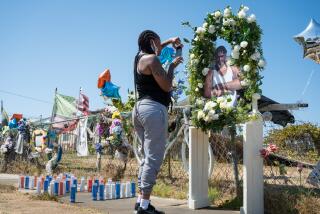Siblings torn apart by gunfire
- Share via
This dispatch is adapted from The Homicide Report, an online project by Times staff writer Jill Leovy to report on every homicide victim in Los Angeles County, including the many whose deaths go unmarked in any other public forum or medium.
--
“Soft-spoken and quiet-like,” is how a friend described Eric Omar Mandeville, 20, killed April 22 in Long Beach. At his funeral last week, a scattered family reunited to mourn the young man, who was shot to death late one night on his way to the local grocery mart.
The slaying is one of more than 335 in Los Angeles County since Jan. 1, a rate of a little less than three a day.
By an overwhelming margin, the victims, like Eric, were black or Latino young men.
Eric had tried hard to beat these statistics.
He earned $6.80 an hour working part time at a McDonald’s in Long Beach. He and his sister Lavonne lived off his paychecks and the wages she earned as a nursing assistant.
The siblings had been raised in foster care. They didn’t know where their father was, said Lavonne, Eric’s elder by five years. Their mother had drug problems, and they grew up without her; for years, Lavonne thought she was dead.
As soon as Lavonne was emancipated from foster care, at age 18, she took her brother out of the system. The two survived however they could, sometimes relying on motel vouchers from homeless shelters to stay off the streets.
They went to school. They worked. Eventually, they were able to afford a small apartment off an alley in North Long Beach. In front, men drank out of cans in paper bags and music boomed from car stereos. But it was an improvement on where they’d been.
Eric would start getting ready for work two hours before he had to leave. He shaved so closely that his neck was peppered with little nicks. He toiled over his shirts, which always looked crisply ironed. He put on his McDonald’s apron and his hat. His sister marveled that he wasn’t embarrassed to wear them on the bus.
“Am I down?” he would ask her, worried that some part of him still did not look groomed. Then he set off, always forgetting to turn off the iron.
His co-workers and bosses knew nothing of his history. He was a well-liked employee -- quiet, earnest, clean-cut. He greeted an older Latina at the restaurant every day in Spanish -- he had learned a few phrases just for her.
He would often ask his bosses how he was doing, how he could get better, said McDonald’s supervisor Don Cunnane. “I still can’t believe it. Such a good kid,” he said.
He and Lavonne had plans. They were going to move out of the county and open a group home for foster children like themselves.
He was shot at 1872 Locust Ave. about 2 a.m. Later that morning, bosses at McDonald’s noticed Eric hadn’t shown up for work. Cunnane was so concerned that he came out to the crime scene when he heard. The killing is still under investigation.
In the days after, Lavonne cried on the floor and had visions of Eric. She thought he was trying to tell her who had killed him.
It took her three days to track down their mother out of state. Lavonne, over the years, had managed to reassemble somewhat the family she and Eric had lost in childhood. By the time the funeral was held, she was surrounded by relatives and friends, including a brother who had been raised separately. But Eric remained the core.
“It was just me and him,” she said. “He was all I had left.”
The Homicide Report is at
https://latimesblogs.latimes.com/homicidereport/
More to Read
Sign up for Essential California
The most important California stories and recommendations in your inbox every morning.
You may occasionally receive promotional content from the Los Angeles Times.










